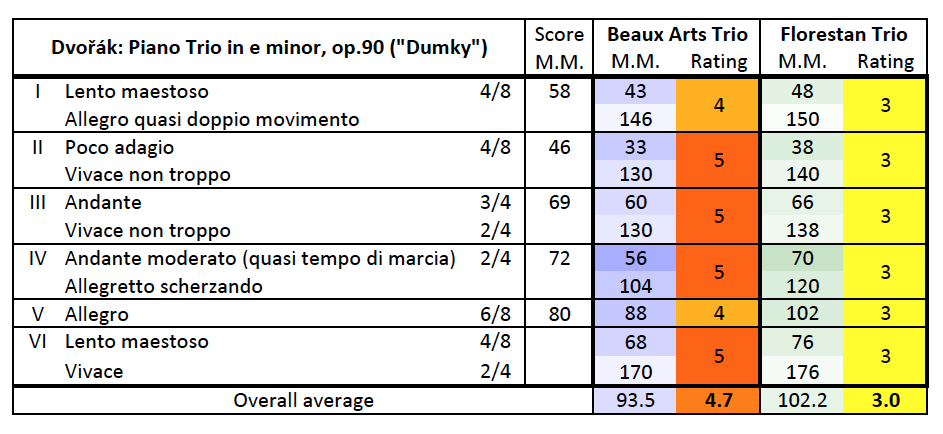Antonín Dvořák
Piano Trio No.4 in E minor, op.90, “Dumky”
Media Review / Comparison
2014-08-27 — Original posting (on Blogger)
2014-09-16 — Added link to review for concert on 2014-09-14
2014-11-03 — Re-posting as is (WordPress)
2016-07-24 — Brushed up for better readability
Table of Contents
Introduction / The Recordings
This posting is about the Piano Trio No.4 in E minor, op.90, “Dumky”, B.166, by Antonín Dvořák (1841 – 1904). That’s Dvořák’s last piano trio, of which I currently have recordings with the following ensembles:
The first one is also part of my LP collection. The second one is an addition in order to have a more recent interpretation for comparison. After all, by comparing multiple recordings, one not only gets a broader scope, but one also learns / tends to listen more carefully, which typically allows for additional insights.
Background, About the Composition
Antonín Dvořák (1841 – 1904) wrote his “Dumky Trio” in 1890/91, after the completion of his eighth symphony (1989) and his Requiem (1890), at a time when he felt emancipated from the music scene in Vienna, and from ties to other composers. This trio in fact is a series of Dumka pieces (plural: Dumky), an Ukrainian elegiac and reflective song type. Dvořák wrote to a friend that these pieces (“Dumky for piano trio”) are “both happy and sad”: in all movements, the tempo is alternating between slow and fast, the mood between sad / longing / elegiac and happy / joyful, and all in “distinctly Czech” tone / harmony, very passionate music. Ever since it was first performed (on April 11th, 1891, with Dvořák at the piano), this composition has been among the most popular and successful by this composer.
The Movements
The “Dumky Trio” has six movements, with the first three following each other without a break (attacca). Some may see this as a reminiscence of the traditional four-movement scheme. My score (Simrock) only has metronome markings for the first tempo in each movement. And these are hardly followed in the two interpretations above. There are no metronome markings at all for the last movement. The “1/8 = 1/16” for the Vivace in the last movement means that a quaver in the new tempo should have the same duration as a semiquaver in the preceding segment. The main annotations for the six movements are as follows:
- Lento maestoso, 4/8 (1/4 = 58) — Allegro quasi doppio movimento — Lento maestoso — Allegro — (attacca)
- Poco adagio, 4/8 (1/4 = 46) — Vivace non troppo — Poco adagio — Vivace — (attacca subito)
- Andante, 3/4 (1/4 = 69) — Vivace non troppo, 2/4 — Andante, 3/4 — Allegretto, 2/4
- Andante moderato (quasi tempo di marcia), 2/4 (1/4 = 72) — Allegretto scherzando — Meno mosso (Tempo I) — Allegro — Tempo I — (pausa lunga)
- Allegro, 6/8 (3/8 = 80)
- Lento maestoso, 4/8 — Vivace, quasi doppio movimento, 2/4 (1/8 = 1/16) — Lento, 4/8 — Vivace
The Interpretations, Overview
In order to provide a rating (1 … 5) overview, as well as an idea about tempo relations both within an interpretation, as well as between the two recordings, I have prepared the little table below. Note that the color coding for the tempo (blue = slower, green = faster) refers to the average between the recordings, not to the metronome markings in the score:
Note that measured metronome values are approximate. Particularly in a composition such as this one, with it’s frequent tempo variations and the like.
The metronome markings in my score (Simrock) are not only incomplete (see above), but also questionable, at the very least. Both interpretations discussed below deviate substantially from these numbers (with very few exceptions). Plus, some of the numbers given in the score appear hardly justified / doable, e.g., a Lento with M.M. 58, or a Poco adagio with M.M. 46. Therefore, I just indicate relative tempo differences in the table above, ignoring the numbers in the score.
The Interpretations, Detail
From my other reviews, one might easily get the impression that in my perception “newer is always better that older recordings”. For classical and baroque music there is certainly some truth in this, especially as for these periods, historically informed performances (HIP) have added so much new insights, new authenticity. However, for more recent compositions, such as from the late romantic period, HIP is adding very little, if any value at all, and hence older recordings stand a much better change against more recent recordings, as the ratings in the above table appear to indicate. Here is a more detailed discussion of the recordings that I listened to:
Beaux Arts Trio
Dvořák: Complete Piano Trios
Philips 454 259-2 (2 CDs, stereo); ℗ 1969 / © 1996
Booklet 6 pages; English

The Artists
The Beaux Arts Trio was founded in 1955 and enjoyed an exceptionally long career until it was disbanded in 2008. Over all of that time, the one constant in that ensemble was the pianist, Menahem Pressler (1923 – 2023). The cellist in this recording, Bernard Greenhouse (1916 – 2011), served the ensemble from the beginning up till 1987, and the violinist here is Isidore Cohen (1922 – 2005), a member of the trio between 1968 and 1992. Throughout its career, this formation received highest acclaims — for good reasons, as this recording (made in 1969) demonstrates.
The Interpretation
In a comparison with the recording below, what strikes me is the clear sound, the balance and clarity both technically (acoustics, microphone placement, etc.), as well as in their playing. Menahem Pressler was a superb pianist and chamber musician, the coordination among the musicians is impeccable, and also the sound of the string instruments is excellent, with a very warm, singing and full sound from the cello, and very good intonation in both string instruments. With very rare exceptions (see below), the vibrato is very natural (around 1900, one can assume that vibrato was applied almost universally), not too nervous, not affecting the intonation. All tempi are slower than those of the recording below. Still, one never gets the feeling of the music lacking tension or being too slow! Here are some remarks on individual movements:
I. Lento maestoso — Allegro
Duration: 4’32”
This interpretation offers way more tension than the recording below. And Menahem Pressler’s articulation is so much more precise, detailed, and “to the point” than in the recording below! Also, the Slavonic character in this music is very prominent here. For example, in the Allegro parts, in the ff sections with the syncopated string passage, Pressler counterbalances the syncopes with accented bass octaves, deemphasizing the chords in the right hand.
II. Poco adagio — Vivace non troppo
Duration: 7’33”
Wonderfully singing not only in the strings, but also in the piano. The second Poco adagio section is of incredible beauty and is very touching: very emotional.
III. Andante — Vivace non troppo
Duration: 6’30”
The melody in the Dumka part of this movement strongly reminds me of the melancholic, hopeless atmosphere in Fellini’s film “La strada”. In these same parts, I should add a note on the con sordino: I think the main reason for the use of the sordino is for changing the sound, i.e., the quality of the sound, not (or not primarily) the volume: after all, the string instruments still need to counterbalance the piano part, and there are limits to how soft a piano can play. Here, the violin may still play a good forte, even with sordino, and there is still all that melancholic expression: wonderful!
IV. Andante moderato — Allegretto scherzando
Duration: 6’04”
The tempo is relatively slow, but that enhances the effect of the rests in the first bars in the piano, giving the impression of a void, of loneliness. I very much like this “Slavonic trait” in the D major section with its enthralling accelerandi: an excellent interpretation, with perfectly coordinated tempo changes. In the last 20 bars, the piano part has explicit pedaling instructions, requiring the sustain pedal to be kept down for entire bars. That is clearly followed by Menahem Pressler!
V. Allegro
Duration: 4’04”
One of the few critical remarks here: there are a few very high solos in the violin, which sound a bit sharp and have a slight excess of vibrato. Also, in the second half of the movement, there is a staccato passage for the two string instruments, which is pretty rough.
VI. Lento maestoso — Vivace
Duration: 4’47”
I love the sound of Isidore Cohen’s violin in that passage on the G-string. The movement is another example of perfect ensemble playing / coordination, not just rhythmically, but also in dynamics and articulation. I’m sure the Dumky Trio was a pièce de résistance for these artists: wonderful!
Conclusion, Rating
Overall duration: 33’29”
Overall rating (see above fort details): 4.7 — Definitely a recommendation, if not (still!) a reference recording!
The Florestan Trio
Dvořák: Piano Trio in F minor, op.65; Piano Trio in E minor, op.90 (“Dumky”)
hyperion CDA66895 (CD, stereo); ℗ / © 1996
Booklet 16 pages; e/f/d

The Artists
The Florestan Trio was founded in 1995, with Susan Tomes (piano), Anthony Marwood (violin), and Richard Lester (cello); the ensemble gave their last concert in 2012. The ensemble enjoyed a good reputation, especially in Britain. In 1999, they received an award for their recording of the first two trios by Robert Schumann. They also received an award for chamber ensemble by Britain’s Royal Philharmonic Society. The above recording was made in 1996.
The Interpretation
To start with the key point: the sound of this recording is fairly awful (compared to the recording by the Beaux Arts Trio, which pre-dates this one by 27 years): it is dull / muffled, and lacks transparency. On top of that, the piano often lacks precision, and the vibrato in the violin is often too strong and heavy, sometimes even affecting the intonation, and for my taste there are sometimes too many portamenti. The violin tone is sometimes also rather rough, sometimes even harsh. Without exception, they prefer faster tempi than the Beaux Arts Trio in this composition. Some remarks on individual movements:
I. Lento maestoso — Allegro
Duration: 3’56”
Especially the Lento is distinctly faster than the Beaux Arts Trio. Consequently, this loses most of the maestoso character (is it even Lento?). To my ears, the piano is less differentiated in dynamics and articulation (especially “internally”, e.g., between the two hands), and the articulation is ofter rather soft, tending towards arpeggiando playing. The transitions to the Allegro parts lacks tension.
II. Poco adagio — Vivace non troppo
Duration: 6’16”
In the transition to the first Vivace non troppo section, there is a segment with arpeggio chords in the piano. The artists combine the crescendo to ff with an accelerando, for no good reason: associating crescendo with accelerando is often considered a bad habit (it may defeat the intensifying effect of the crescendo). Also here, the transitions to faster parts lack intensity / tension, compared to the Beaux Arts Trio.
III. Andante — Vivace non troppo
Duration: 5’48”
The con sordino often sounds too muffled. And when they want to add expression, the strings (especially the violin) add an excess of vibrato and portamento, sometimes even affecting the purity of the intonation.
IV. Andante moderato — Allegretto scherzando
Duration: 4’39”
With their faster tempo (I don’t think that’s moderato any longer), the artists totally defeat the effect of the rests in the piano part at the beginning of this movement. The chance to build tension in the transition to the first Allegretto scherzando is entirely skipped: too bad! Around the middle of the movement, in the second Allegretto scherzando there is a Meno mosso (Tempo I). To me, this rather sounds Più mosso. It may indeed be Tempo I, but if so, the preceding bars are too slow. The tempo changes don’t come close to the perfection in coordination that I enjoyed with the Beaux Arts Trio. In the last 20 bars, the pedaling instructions in the piano are clearly ignored.
V. Allegro
Duration: 3’42”
Disappointment right at the beginning: the first bar has no arpeggio in the score. Why are these chords played arpeggiando? This alters the character of the piece! Also, the intonation in the high solo passages in the violin is fairly marginal. Maybe the tempo is slightly too fast: the articulation starts to suffer, in that punctuations are sometimes softened, and some of the semiquaver passages tend to be superficial. The staccato sequence is rough here, too.
VI. Lento maestoso — Vivace
Duration: 4’32”
In bar 9 there is a Poco più mosso. I fail to understand why these artists do a distinct, clear meno mosso instead! In the Lento part, the violin solo is annotated Sul G (on the G-string). This is written for the specific sound quality of higher positions on the lowest string. Anthony Marwood adds an excess of vibrato for more expression, hereby defeating that special sound effect / quality.
Conclusion, Rating
Overall duration: 28’52”
Overall rating (see above for details): 3.0 — Sorry, I can’t recommend this recording!
Addendum
Dvořák’s “Dumky-Trio” was featured in a chamber music concert at the Tonhalle in Zurich, with Yuja Wang, Klaidi Sahatçi, and Thomas Grossenbacher. See my concert review in the posting “Tonhalle Zurich, 2014-09-14: Chamber Music with Yuja Wang“.







